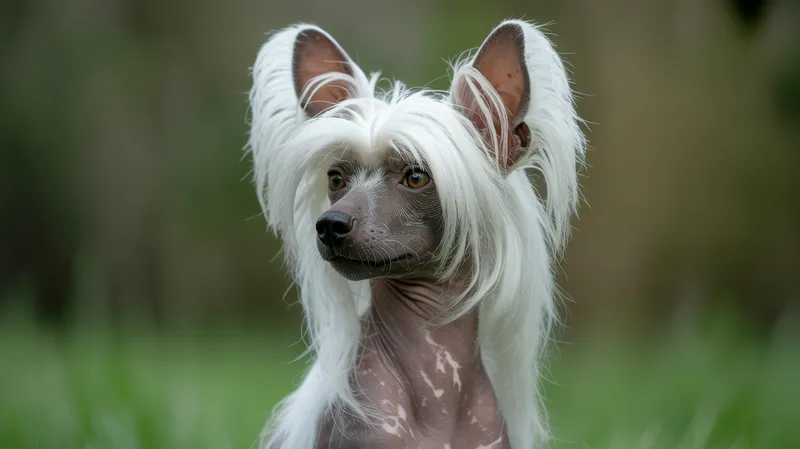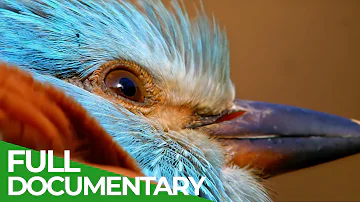
Chinese Crested
Canis lupus familiaris

Meet the Chinese Crested
The Chinese Crested is a small, affectionate toy dog breed known for its unique appearance featuring hairless and powderpuff (coated) varieties. The hairless variety has smooth, exposed skin with tufts of silky hair on the head (crest), tail (plume), and feet (socks), while the powderpuff variety is covered in a soft, long double coat. Despite their delicate look, Chinese Cresteds are lively, agile, and surprisingly athletic. They are highly social, enjoy companionship, and often form strong bonds with their families. This breed is popular as a companion animal due to its playful, gentle nature and minimal shedding.
Classification
Mammal
Habitat
Domestic environments
Diet
Omnivore
Lifespan
13-18 years
Conservation
Least Concern
Weight
5-12 lbs (2.3-5.4 kg)
📖Fascinating Facts
Unique Coat Types
Chinese Cresteds can be either hairless or fully coated (powderpuff), and both types can be born in the same litter.
Companion Breed
This breed thrives on human companionship and can develop separation anxiety if left alone for long periods.
Skin Care Needs
Hairless Chinese Cresteds require regular skin care, including moisturizing and sun protection, to prevent dryness and sunburn.
📋Detailed Description
The Chinese Crested Dog is a small, fine-boned toy breed, typically weighing between 2.3 and 5.4 kg (5–12 lbs) and standing 23–33 cm (9–13 in) at the shoulder. The breed is unique in that it exists in two distinct varieties: the 'Hairless,' which has soft, exposed skin with tufts of long, silky hair on the head (crest), tail (plume), and feet (socks), and the 'Powderpuff,' which is fully coated with a long, soft double coat. The skin of the hairless variety is prone to sunburn and requires diligent care, while the powderpuff's coat demands regular grooming to prevent matting. Chinese Cresteds have a slender, graceful build with elongated limbs and a slightly arched neck, contributing to their agile and athletic movement. Their expressive, almond-shaped eyes and large, erect ears give them a distinctive, alert appearance. Behaviorally, they are known for their affectionate, playful, and gentle temperament, often forming strong bonds with their human families and displaying a pronounced preference for close physical contact. Despite their delicate look, they are robust, lively, and excel at activities such as agility and obedience. The breed is highly intelligent, responsive to training, and tends to be reserved with strangers but rarely aggressive. Chinese Cresteds are generally long-lived, with a typical lifespan of 13–18 years, and are considered hypoallergenic due to minimal shedding, though skin and dental care are essential. Their unique appearance and engaging personality have made them popular as companion animals worldwide.
💡 Did you know?
The 'hairless' gene is actually lethal in its homozygous form, so all hairless Chinese Cresteds carry one copy of the gene and one for the powderpuff coat.
🔬Research & Sources
Wikipedia Summary
The Chinese Crested Dog is a hairless breed of dog. Like most hairless dog breeds, the Chinese Crested Dog comes in two varieties, without hair and with hair, which can be born in the same litter: the hairless and the powderpuff.
Last Modified: 5/26/2025
🎭Behavior & Social Structure
Chinese Cresteds are highly social and thrive on human companionship, often seeking to be close to their owners and displaying separation anxiety if left alone for extended periods. They are alert and quick to respond to environmental stimuli, making them effective watchdogs despite their small size. Playful and energetic, they enjoy interactive games and moderate exercise, such as short walks and agility courses. The breed is not prone to excessive barking but will vocalize to alert their owners to unfamiliar sounds or visitors. Cresteds are generally good with children and other pets if properly socialized from a young age. Their feeding behavior is typical of small companion breeds, requiring a balanced diet tailored to their size and activity level. They are known for their cleanliness and often exhibit cat-like grooming behaviors. Daily routines typically include periods of active play interspersed with long stretches of rest, often cuddled with their owners or in warm, comfortable spots.
👶Reproduction & Life Cycle
Chinese Cresteds reach sexual maturity between 6 and 12 months of age. The breed does not have a specific breeding season, as domestic dogs are capable of breeding year-round. The female's estrous cycle occurs approximately every 6–8 months, with gestation lasting about 58–63 days. Litter sizes typically range from 2 to 5 puppies, and both hairless and powderpuff varieties can be born in the same litter due to the breed's unique genetic inheritance (the hairless trait is an incomplete dominant gene, and homozygosity for the hairless gene is embryonically lethal). Parental care is primarily provided by the mother, who nurses and grooms the puppies until weaning at around 6–8 weeks. Responsible breeders perform health screenings to avoid hereditary issues such as dental anomalies and eye disorders. Early socialization and gentle handling are important for proper behavioral development.
🛡️Adaptations & Survival
The most notable adaptation of the Chinese Crested is its hairless phenotype, which is thought to have evolved as a response to warm, humid climates, reducing the risk of ectoparasites and overheating. The breed's exposed skin necessitates behavioral adaptations, such as seeking warmth and avoiding prolonged sun exposure, often resulting in a preference for burrowing under blankets or cuddling with humans. The powderpuff variety, with its insulating double coat, is better suited to cooler environments. Both varieties have elongated limbs and a lightweight build, enhancing agility and speed. The breed is also known for its dental peculiarities, particularly in the hairless variety, which often exhibits missing or malformed teeth due to the same gene responsible for hairlessness. Socially, their strong attachment to humans and adaptability to various living environments are key behavioral adaptations that have ensured their success as companion animals.
📚Research Sources
🎨Cultural Significance
The Chinese Crested has a long and somewhat mysterious history, with origins believed to trace back to African or Asian hairless dogs that were later refined in China. Historically, they were favored as companion animals by Chinese sailors, who reportedly used them as ratters on ships and traded them at various ports, contributing to their global spread. The breed has been featured in art, literature, and popular culture, often celebrated for its unusual appearance and affectionate nature. In modern times, Chinese Cresteds are frequently seen in dog shows and have gained notoriety through media appearances, including winning 'World's Ugliest Dog' contests (often due to the unique look of some hairless individuals). They symbolize uniqueness, companionship, and adaptability in various cultures.
🔬Recent Research & Discoveries
Recent genetic studies have identified the FOXI3 gene as responsible for the hairless trait in Chinese Cresteds, which also affects dental development. Ongoing research focuses on the health implications of this gene, particularly in relation to skin and dental disorders. Comparative studies with other hairless breeds, such as the Xoloitzcuintli and Peruvian Inca Orchid, are providing insights into the convergent evolution of hairlessness in domestic dogs. Behavioral research highlights the breed's strong attachment behaviors and suitability as therapy animals. Veterinary studies continue to investigate optimal skin care, dietary needs, and preventive health strategies for both varieties. The breed's unique genetics make it a valuable model for understanding ectodermal dysplasias in mammals.
🎥Wildlife Videos

Wild China - Fantastic Creatures of Yunnan | Free Documentary Nature
Wild China - Fantastic Creatures of Yunnan | Free Documentary Nature Watch 'A Wildlife Odyssey - Southeast Asia's Island ...
Free Documentary - Nature

Wild Asia - Fantastic Creatures of Tian Shan | Free Documentary Nature
Kingdom of the Bears: Masters of Wilderness | Free Documentary Nature Kingdom of the Bears: Asia's Brown Bear Mountains ...
Free Documentary - Nature

Wildest Indochina | Episode 5: China - The Secret Garden | Free Documentary Nature
Wildest Indochina - Episode 5: China - The Secret Garden | Wildlife Documentary Wach 'Wildest Indochina - Episode 1' here: ...
Free Documentary - Nature

Birds Of China | Most Beautiful Birds in China You’ve Never Seen Before | BBTV Official
At the intersection of towering mountains, ancient rivers, and primeval forests, China emerges not only as a cultural and historical ...
BBTV Official

Zhejiang Xiangshan Series: Return of the mythical bird
In 2004, the long-disappeared Chinese crested terns returned to the East China Sea. To ensure that the birds return each year for ...
CGTN Nature

The Triumphant Return of the Chinese Crested Tern: A Conservation Success Story from Xiangshan
Just around 2000, some birds were seen on islands between Zhejiang and Taiwan. Since then they 've been discovered in more ...
Insight Xiangshan
🌍Habitat Information
The Chinese Crested typically inhabits Domestic environments environments. Chinese Cresteds have adapted to their environments with specialized features and behaviors.
Primary Habitat:
Domestic environments
More detailed habitat information will be available soon.
🛡️Conservation Status
The Chinese Crested is currently classified as Least Concern. Conservation efforts are crucial for preserving this species for future generations.
Common Threats:
- 🏠Habitat loss and fragmentation
- 🌡️Climate change impacts
- 🎯Hunting and poaching
- 🏭Human-wildlife conflict
⚠️Threats & Conservation Challenges
As a domesticated breed, the Chinese Crested faces few natural threats, but it is susceptible to several health challenges, including dental disease (especially in hairless individuals), skin conditions (such as acne, sunburn, and allergies), and patellar luxation. The breed's popularity has led to irresponsible breeding in some regions, increasing the risk of inherited disorders. Overexposure to sunlight can result in skin cancer, while lack of proper grooming in powderpuffs can lead to matting and skin infections. While the global population is stable and the breed is not at risk of extinction, maintaining genetic diversity and health standards remains a challenge for breeders and enthusiasts. There are no significant conservation concerns, but ongoing education about responsible ownership and breeding is essential.
🔬Scientific Classification
Scientific Name
Canis lupus familiaris
Classification Hierarchy
🔍 About Taxonomic Classification
Taxonomic classification is a hierarchical system used by scientists to classify and organize living organisms based on shared characteristics and evolutionary relationships.
The system moves from broad categories (Kingdom) to increasingly specific ones, with each animal's scientific name typically consisting of its Genus and species.
📝Community Notes
Share your observations and insights about the Chinese Crested with our community of wildlife enthusiasts.
Join Our Community
Sign in to share your observations and connect with fellow wildlife enthusiasts.
Sign In to ContributeNo community notes yet
Be the first to share your observations about the Chinese Crested!
Explore Chinese Crested
Select a tab above to learn more about this amazing animal.
📸Photo Gallery
No photos available for this animal yet.
🌟Discover More Wildlife
Continue your journey of discovery with more fascinating animals from our database
